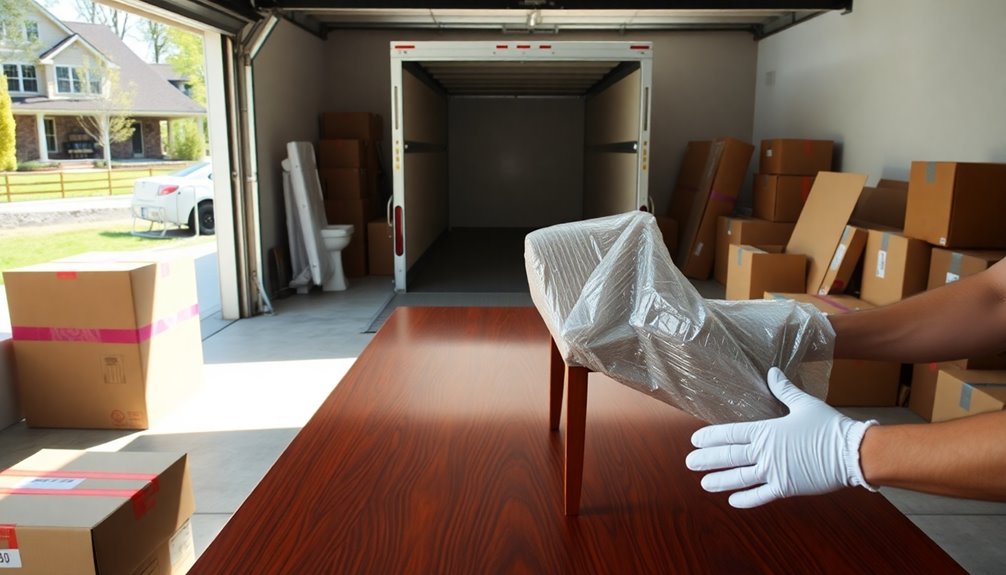To ship furniture to another state, start by understanding the costs, which can range from $300 to over $4,000 depending on distance and item size. Prepare your furniture by cleaning it, inspecting for damages, and disassembling larger pieces if needed. Use protective wrapping and sturdy packing materials to avoid damage. Choose a shipping method like Less-Than-Truckload (LTL) for smaller loads or freight shipping for larger ones. Don't forget to compare quotes to save money. With the right preparation and method, your furniture will arrive safely. There's more to consider, so keep exploring your options.
Key Takeaways
- Determine shipping costs based on distance, size, and weight to budget accordingly for interstate furniture transport.
- Disassemble large items and securely wrap fragile parts to minimize damage during shipping.
- Choose the right shipping method, such as LTL or consolidated shipping, for cost-effectiveness based on your load size.
- Research and compare quotes from various carriers to find the best rates and services for long-distance shipping.
- Use tracking tools and maintain communication with the carrier to stay updated on your shipment's status.
Understanding Shipping Costs
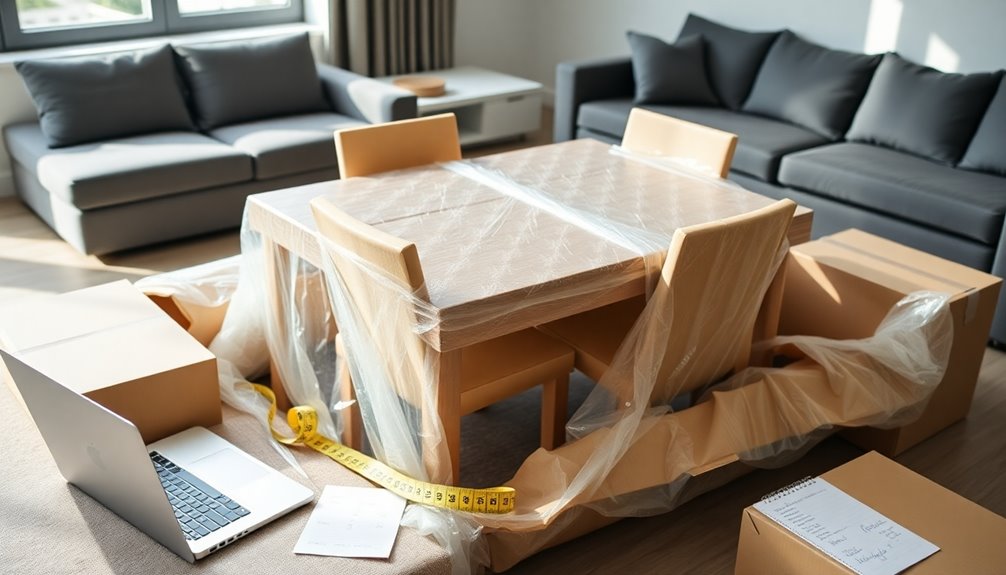
When it comes to shipping furniture, understanding shipping costs is essential for budgeting your move. The distance you're shipping significantly impacts the overall price. Local deliveries typically range from $75 to $250, while long-distance shipping can set you back anywhere from $300 to $600 or more. If you're moving cross-country, be prepared for costs that can soar to $4,000 for multiple pieces.
Freight class also plays a crucial role in determining your shipping costs. This classification depends on the density and contents of your packages. Using Less Than Truckload (LTL) freight can help you save money, especially if you have an existing carrier account, as it often offers lower rates. Additionally, it's important to note that distance significantly impacts shipping quotes, as larger distances typically incur higher costs.
You should also consider additional fees for oversized or fragile items, which might require special handling and packaging. Extra services like expedited shipping or white glove services will add to your expenses. Remember, comparing quotes from different carriers can reveal hidden savings, so don't hesitate to shop around. Understanding these factors will empower you to make informed decisions and manage your budget effectively for your furniture shipping needs.
Factors Influencing Costs
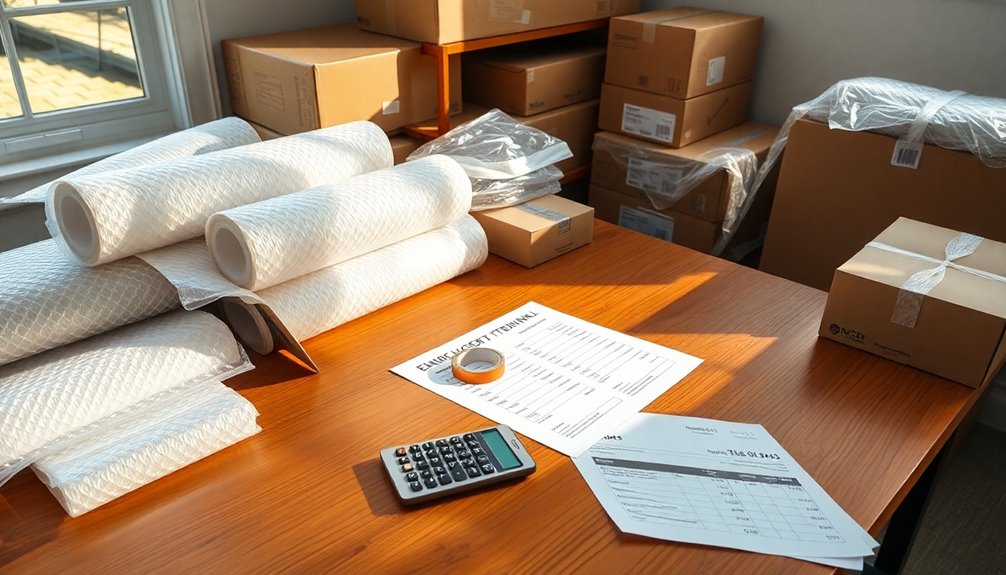
Considering various factors can significantly influence your furniture shipping costs. First, the shipping distance plays a crucial role; longer routes mean increased fuel consumption and labor expenses. If you're shipping across the country, expect costs to soar up to $4,000, with large items ranging from $300 to $800 each. Additionally, remote areas can hike your costs due to challenging logistics.
The size, weight, and fragility of your furniture also impact expenses. Larger and heavier items require more space and effort to handle, often necessitating special insurance. Fragile pieces need extra care, resulting in additional packaging costs. Accurate measurements are essential to avoid surprises.
Pickup and delivery locations matter too. Urban areas usually offer competitive rates, while rural spots incur higher charges due to logistical challenges. Traffic and parking restrictions can further affect delivery costs. Moreover, understanding market dynamics, including peak seasons and demand fluctuations, can also drive prices up.
Lastly, consider any additional services you might need. Expedited shipping or white glove services will increase your total costs. If you can, consolidate shipments for potential savings.
Preparing Your Furniture
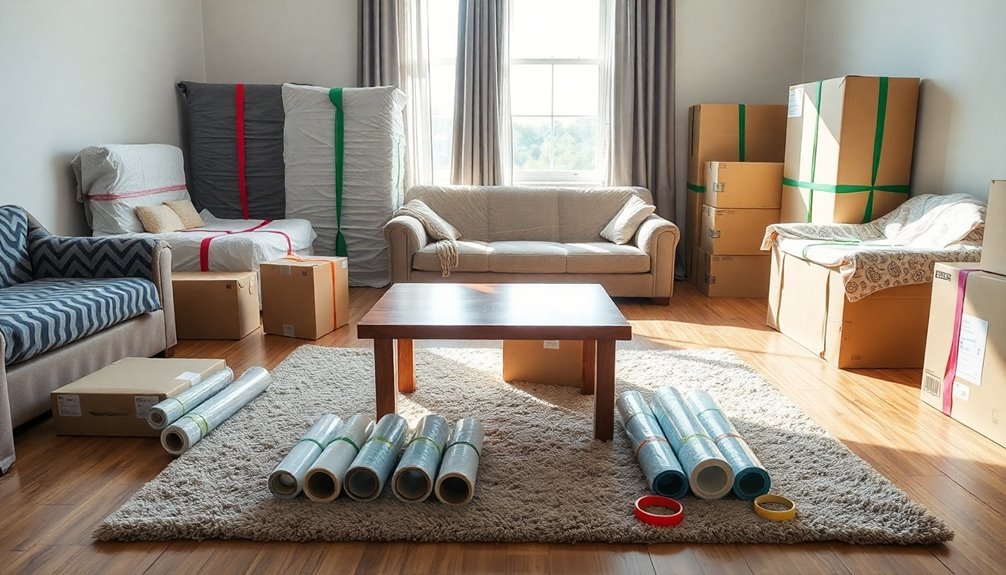
Preparing your furniture for shipping requires careful attention to detail to ensure it arrives safely at its destination. Start by cleaning your furniture to remove any dust and dirt. Inspect each piece for existing damages, noting any scratches or dents. Remove loose or fragile items from within the furniture and dust surfaces to prevent scratches from trapped debris. Taking photos or notes of the furniture’s condition before shipping can be helpful. When disassembling furniture for shipping, keep all hardware and small parts in a labeled bag to avoid losing them during transit. Protect delicate surfaces by wrapping them in bubble wrap or furniture blankets, and consider using corner protectors to prevent damage to edges and corners. If you have a fabric sofa, be sure to research fabric sofa cleaning tips to properly maintain and clean the upholstery before shipping. This will help ensure that your furniture arrives in the best possible condition at its destination.
If you have large furniture, disassemble it if possible. This makes movement easier and minimizes damage. Keep screws, nuts, and bolts in labeled bags. If you're packing dressers or cabinets, consider removing drawers and packing them separately, or keep their contents in place if necessary. Wrap fragile parts like glass tabletops in bubble wrap or packing paper for protection.
When wrapping larger items, use moving blankets, bubble wrap, or furniture pads, securing everything with packing tape. An "X" pattern with your tape helps ensure stability. Finally, wrap each piece individually, using stretch wrap to keep drawers closed and secure any loose components. This thorough preparation will help your furniture arrive in excellent condition. Proper wrapping significantly reduces the risk of damage during transportation.
Shipping Methods Overview

Choosing the right shipping method for your furniture is crucial to ensure it arrives safely and cost-effectively. There are several options available, depending on your shipment size and budget.
Less-Than-Truckload (LTL) shipping is ideal for smaller loads that don't fill an entire truck. You'll only pay for the space your furniture occupies, making it often the cheapest choice. However, keep in mind that LTL may involve transfers between trucks, which could increase transit time.
Freight shipping includes both full truckload (FTL) and LTL services. FTL suits larger shipments, while LTL is more economical for smaller loads. Freight carriers specialize in handling heavy shipments and can offer expedited options if you need faster delivery. Understanding service differences helps in cost savings.
Consolidated shipping combines multiple shipments going to similar destinations, optimizing routes and reducing costs. It's a great option for smaller loads, as you'll share expenses with other shippers.
Lastly, self-moving gives you complete control but requires more effort. Alternatively, independent transporters can provide discounted rates if you connect with them through platforms like uShip. Each method has its benefits, so choose the one that aligns best with your needs.
Additional Costs to Consider
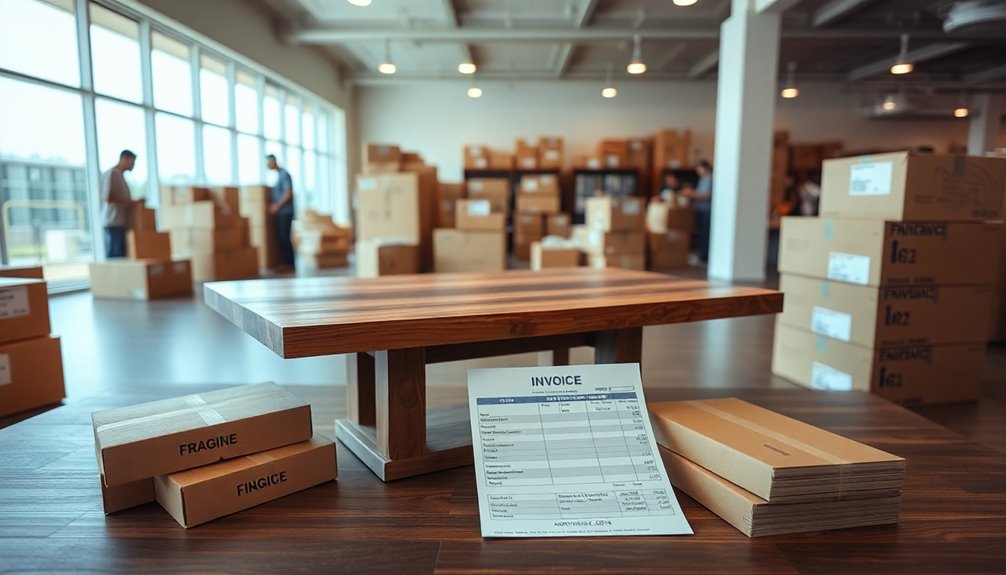
Shipping furniture involves various additional costs that can significantly impact your overall budget. First, consider the shipping distance. Longer moves often mean higher fuel consumption, which can drive up costs. Labor expenses also increase with longer travel times, leading to more days worked by your moving crew. If you're shipping internationally, be prepared for even steeper costs due to customs and robust packaging requirements.
Next, think about the size and fragility of your items. Oversized or delicate furniture requires extra handling and materials, which can add to your expenses. Antique pieces may need additional protection, and disassembly or reassembly of modular furniture could incur further fees. Additionally, consider that heavier and bulkier items incur higher shipping costs, which can further strain your budget.
Location plays a big role too. Urban areas usually offer competitive rates, while rural locations can lead to increased charges due to longer distances and accessibility challenges.
Lastly, consider timing and additional services. Expedited shipping or guaranteed delivery windows can come with higher fees, and opting for extra services like white glove assistance will raise your costs. By being aware of these factors, you can better manage your shipping budget.
Tracking Your Shipment
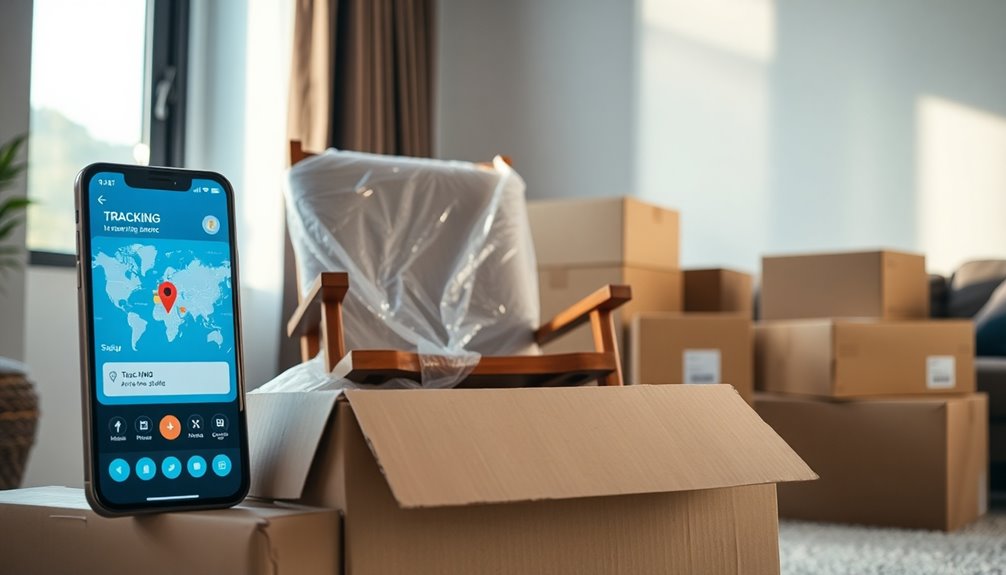
Once you've accounted for the additional costs, tracking your shipment becomes a vital part of the process. You'll want to use the tracking number provided by your shipping carrier to monitor your furniture's journey. Most carriers offer online tracking through their websites or dedicated tracking pages, making it easy to stay updated. For long-haul shipments, consider utilizing GPS devices for real-time location data, which can provide peace of mind.
Real-time updates are essential, as they notify you of any changes or issues during transit. If you're shipping sensitive goods, IoT sensors can help you monitor conditions like temperature and humidity. This way, you can address potential delays or problems promptly. Additionally, using advanced algorithms can help optimize delivery routes, ensuring your furniture arrives on time and in perfect condition.
To enhance your tracking experience, explore mobile apps from logistics companies that offer direct communication with the carrier and allow you to track shipments independently. Tools like ShipperHQ and uShip can simplify the process, while advanced logistics software like Locate2u streamlines tracking and dispatch.
Finally, proactive customer communication is key. Keeping your customers informed with automated notifications boosts satisfaction and ensures transparency about the current status and location of their furniture.
Frequently Asked Questions
What Documentation Is Needed for Shipping Furniture to Another State?
When you're preparing to ship furniture, you'll need several key documents. Start by taking clear photos to document the furniture's condition. Create an inventory list detailing all items being shipped. Clearly label each piece with its contents and any special handling instructions. Keep records of how to disassemble the furniture and note any existing damage. This documentation will help protect you and simplify the shipping process.
Can I Ship Assembled Furniture, or Should It Be Disassembled?
You can ship assembled furniture, but disassembling it is often a smarter choice. Assembled pieces are bulkier and more prone to damage during transit, making them harder to maneuver. By taking apart your furniture, you reduce the risk of scratches and breakage, simplify transport, and potentially save on costs. Plus, smaller parts are easier to wrap and protect. Consider disassembling for a smoother, safer shipping experience.
How Do I Choose a Reliable Furniture Shipping Company?
To choose a reliable furniture shipping company, start by researching various options online. Compare prices and services offered by different companies, and read customer reviews for insights. Verify their experience in the industry and check for necessary licenses and insurance. Evaluate their customer service reputation and look for additional services like packing or white-glove delivery. Finally, ensure they keep you updated on your shipment's status throughout the process.
Are There Restrictions on Shipping Certain Types of Furniture?
Yes, there are restrictions on shipping certain types of furniture. Weight and size limitations vary by carrier, with FedEx and UPS having specific maximums. Fragile items need extra protective measures like bubble wrap and foam padding. You should disassemble large pieces to prevent damage, keeping hardware organized. Also, check for any legal requirements before shipping. It's crucial to communicate with your carrier to ensure a smooth pickup and delivery process.
What Should I Do if My Furniture Gets Damaged During Shipping?
If your furniture gets damaged during shipping, act quickly. Document the damage on the delivery receipt and take photos for evidence. Notify the carrier or broker as soon as you can. Keep the damaged items until your claim's resolved, and don't discard anything. Gather necessary documents like the bill of lading and proof of delivery. Submit a claim detailing the loss, including repair estimates, within the required timeframes for a smoother process.
Conclusion
Shipping furniture to another state doesn't have to be stressful. By understanding the costs involved, preparing your items properly, and choosing the right shipping method, you can ensure a smooth process. Don't forget to factor in any additional expenses and keep track of your shipment for peace of mind. With a little planning, you can get your furniture to its new home safely and efficiently. Happy moving!
